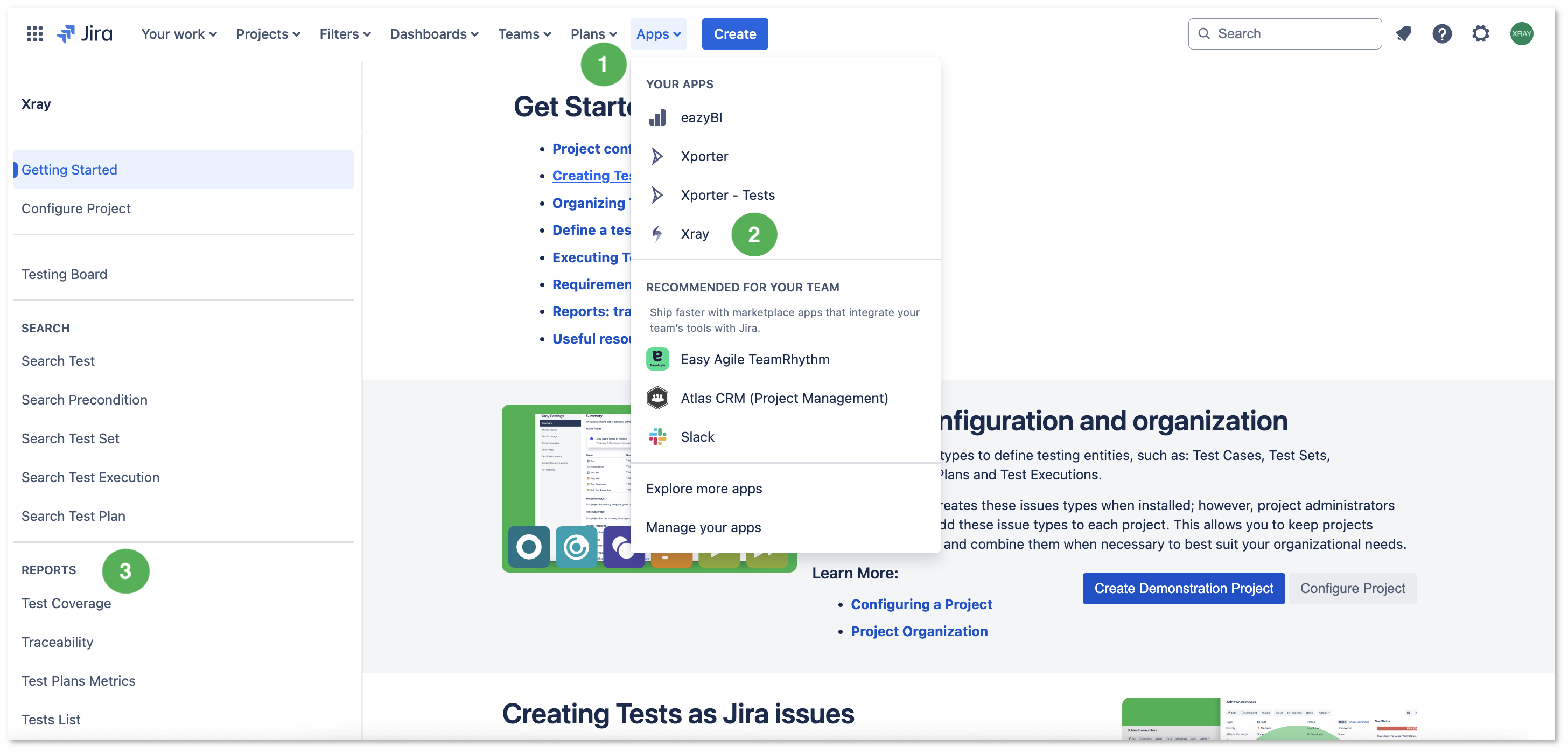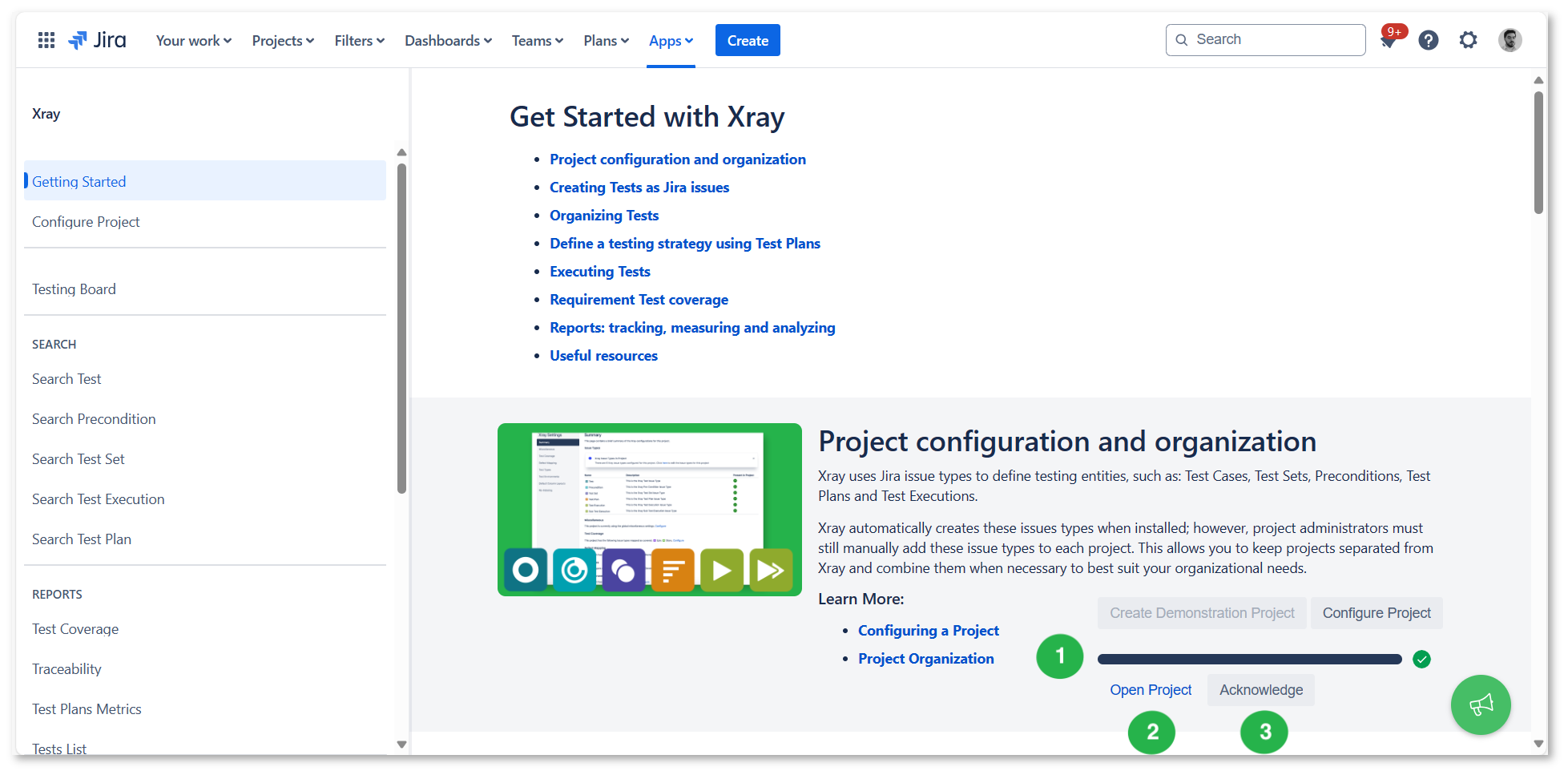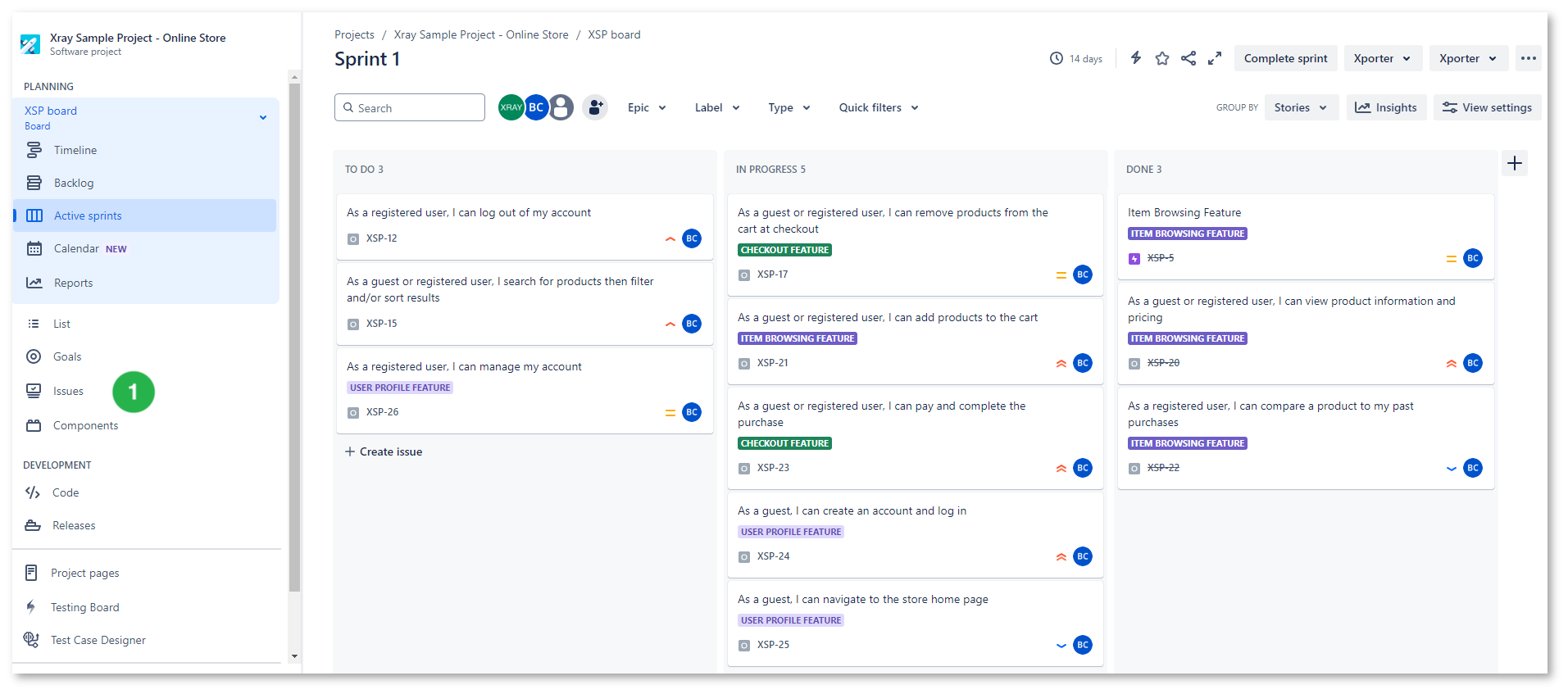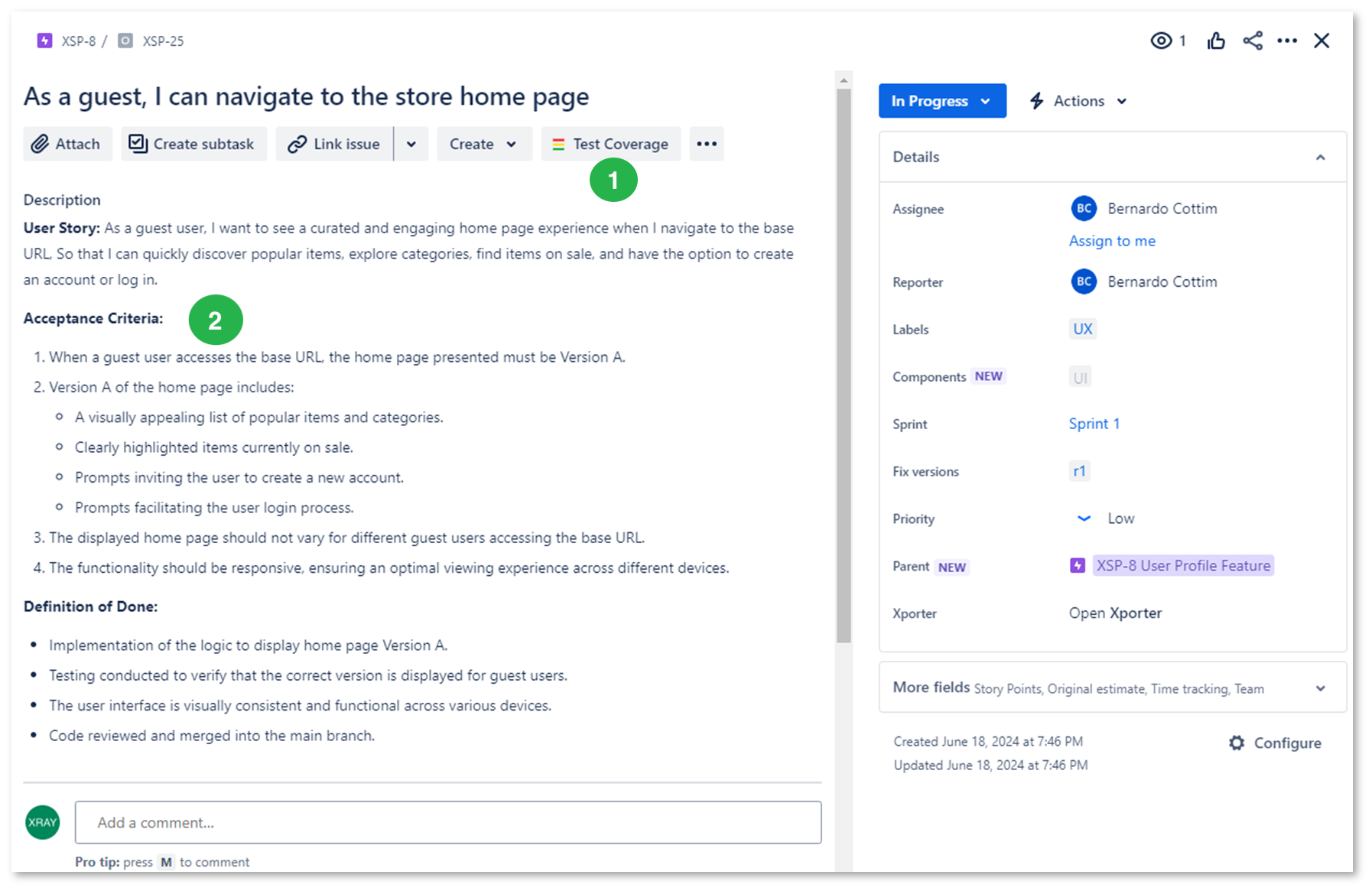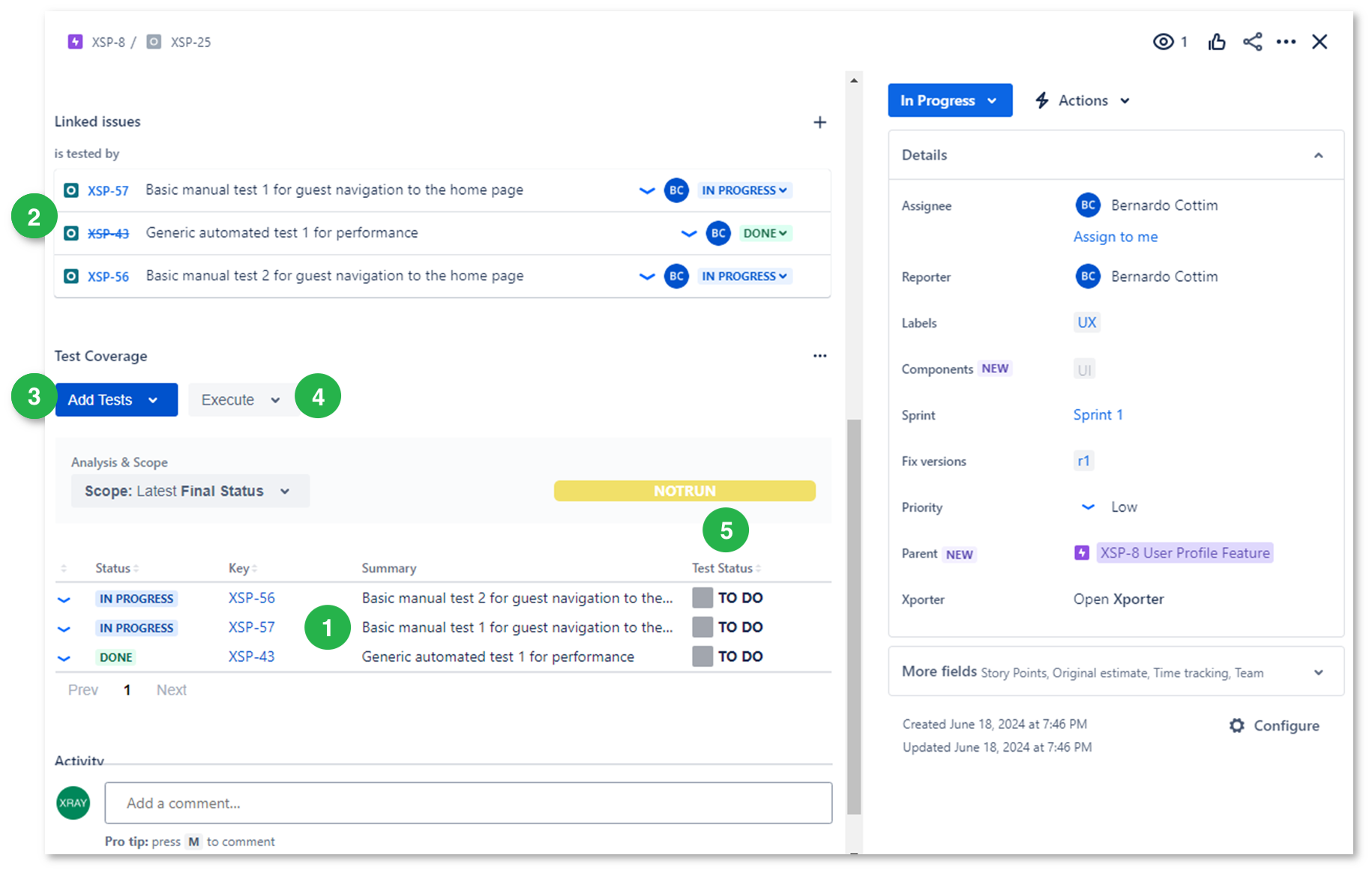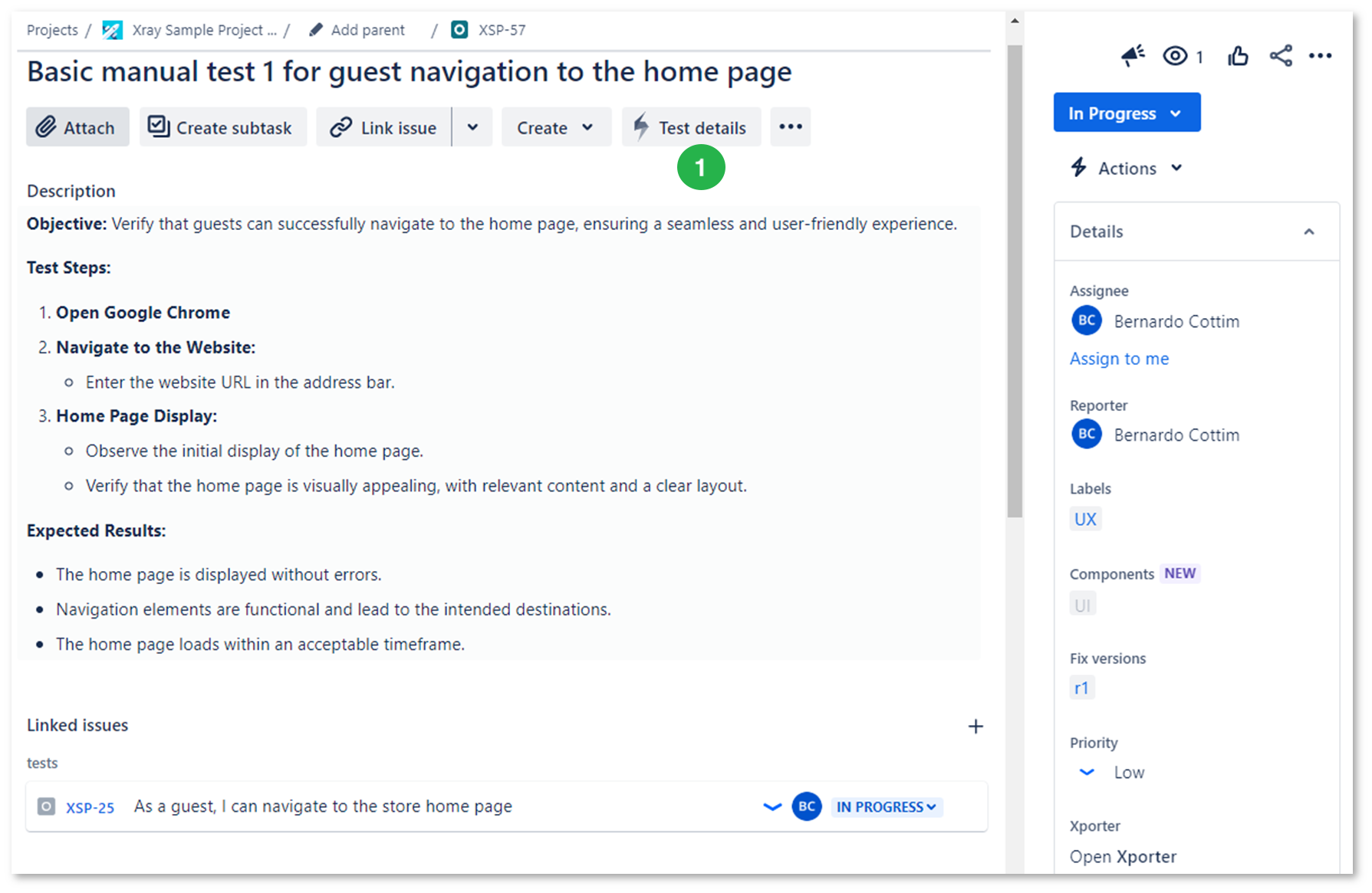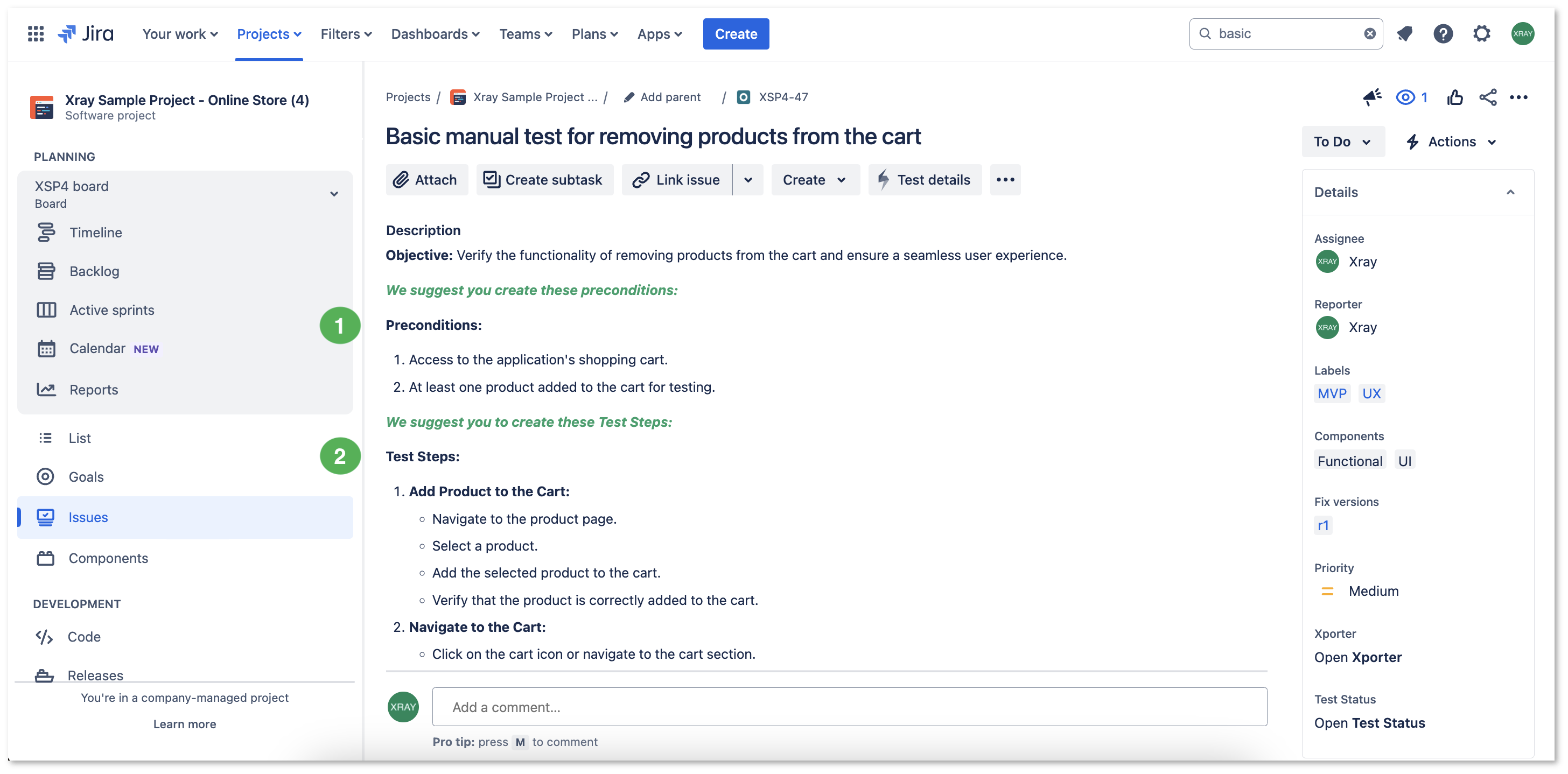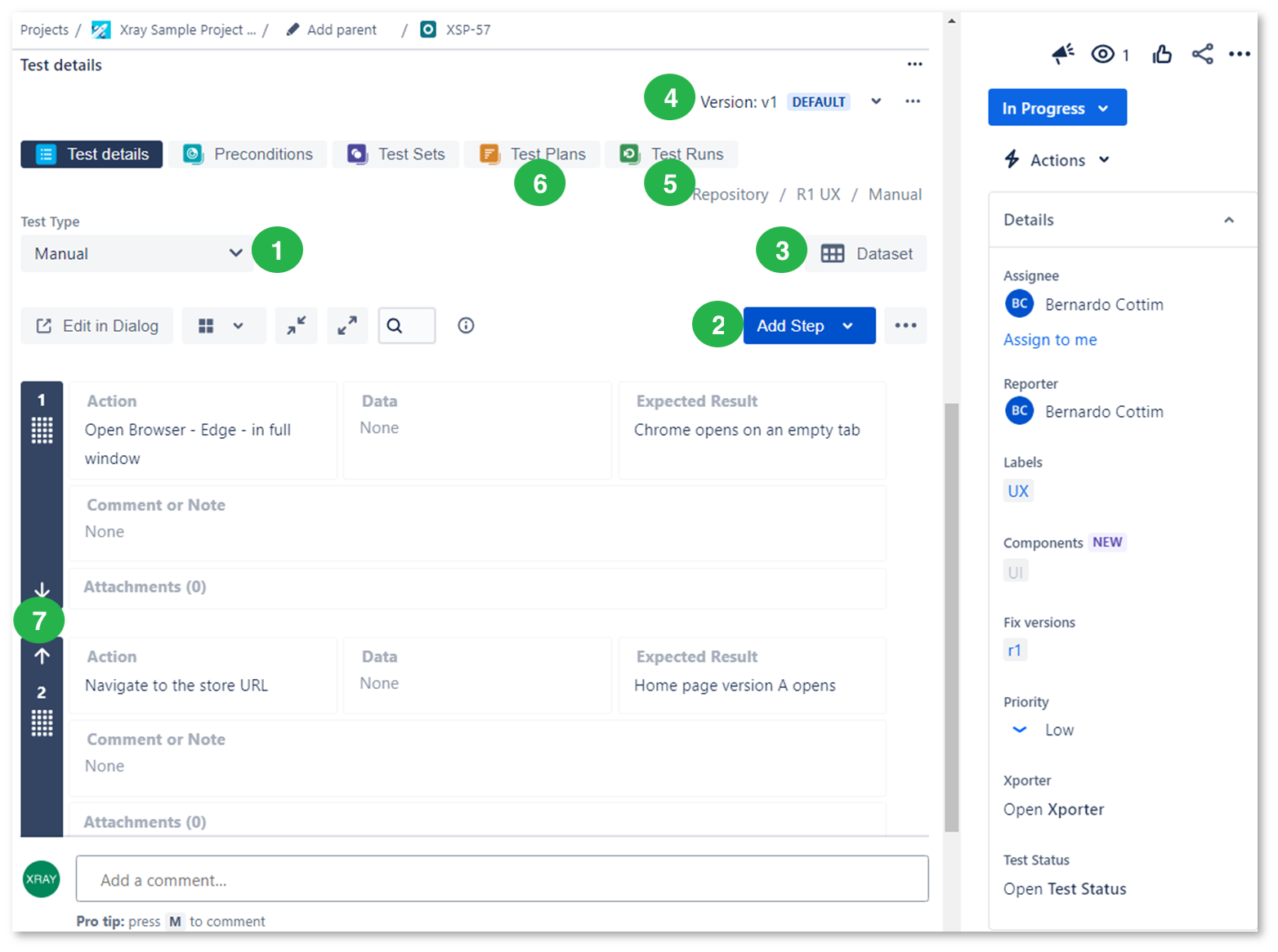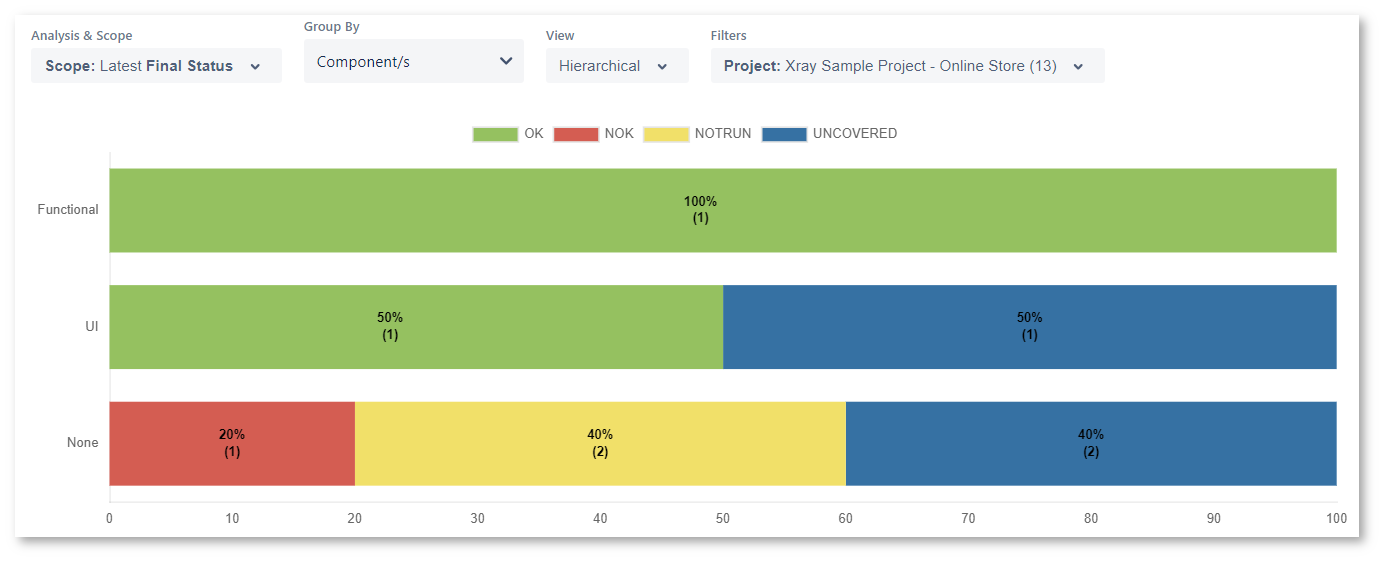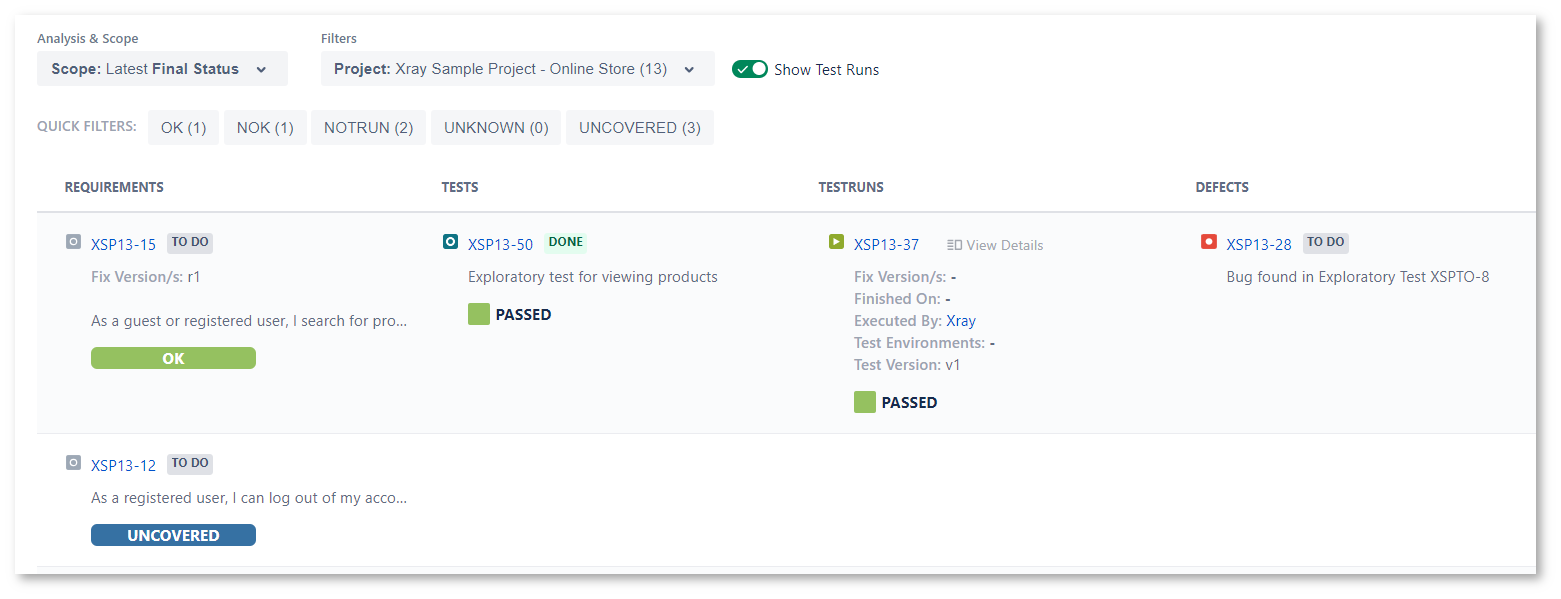Introduction
Designed to offer a starting point for your Xray experience, Demonstration Project provides a pre-populated Project environment to help you get started with Xray quickly and easily.
Key Benefits
- Effortless learning: if you just want to learn how Xray works, skip the initial setup and dive right into exploring Xray's functionalities.
- Pre-populated playground: experiment with a realistic testing scenario populated with Issues from Jira and Xray.
- Standard vs Enterprise Features: understand the core functionalities of Xray's Standard Edition, and for Xray Enterprise users, explore advanced features like Test Case Versioning and Dynamic Test Plans.
Components
- Sample Sprint data: The set of pre-populated Issues from Jira and Xray provides context for testing activities. The data within the Demonstration Project is for informational purposes only.
- Reporting: Demonstration Project also enables the use of Xray reports like Coverage, Traceability, and more.
Xray Enterprise Features in Demonstration Project
- Test Case Versioning: create multiple versions of your test cases to adapt seamlessly to your use cases.
- Dynamic Test Plans: build flexible test plans using Jira filters that adapt to your evolving testing needs.
Available only for Xray Enterprise customers, and/or Xray customers with an active Xray Enterprise trial.
Creating and Accessing Demonstration Project
Only users with permission to create Projects can utilize Xray Demonstration Project.
On your Jira Cloud instance, click Apps (Figure 1 - 1) and then Xray (Figure 1 - 2).
Figure 1 - Apps
You will land on the Getting Started screen (Figure 2 - 1).
To generate a new Demonstration Project, click the Create Demonstration Project button (Figure 2 - 2).
Figure 2 - Getting started
A modal will open for confirmation. Click Confirm (Figure 2 - 3).
The Demonstration Project creation process will start (Figure 3).
Figure 3 - Process
Here, you can:
- Check the process of creating a Demonstration Project (Figure 3 - 1). Once the process is complete (green checkmark), the Demonstration Project will be deployed and appear in your Projects list.
- Open the newly created Demonstration Project (Figure 3 - 2). This will take you to the screen depicted in Figure 4 below.
- Acknowledge the Demonstration Project creation (Figure 3 - 3) without immediately opening it.
- Project Name: Xray Sample Project - Online Store.
- Type: software development project.
- Management: company-managed.
- User Assignment: the person clicking "Create" will be associated with all the issues in this project
It uses a single Project to manage your requirements, test-related Issues, as well as all your executions and defects.
Exploring a Demonstration Project
The Demonstration Project's pre-populated sample data environment offers a realistic testing scenario, allowing you to understand and make use of Xray's capabilities.
You cannot customize which data is deployed in the project initially. However, after creating a Demonstration Project, you can update the Issues (edit the summary or the description, add more tests, etc.).
Example
A company in this scenario operates in the e-commerce industry and is developing its first online store. The company is using Scrum methodology for the project. Major requirements for the first release are outlined, and thorough testing of all types is necessary.
Let's dive into the key implementation steps involving Xray and Jira.
Requirements
Your typical flow in this kind of project would likely start with the Sprint board (Figure 4).
Figure 4 - Sprint board
This board is already populated with several requirement Stories for "Sprint 1" (Figure 4). We also chose to display parent Epics (colored rectangles) for easier classification.
Open one of the stories "In Progress": "As a guest, I can navigate to the store home page" (Figure 5).
Figure 5 - Sample requirement story
The Issue descriptions are also prefilled with relevant business and/or testing information, such as Acceptance Criteria (Figure 5 - 2), to help you track the development flow with more context.
But the key aspect to highlight here is the Test Coverage button on the top (Figure 5 - 1). Click it.
Test Coverage Section
Figure 6 - Test Coverage
Here, you can:
- See the list of associated tests (Figure 6 - 1), as well as the Linked Issues section (Figure 6 - 2). Xray entities are native Jira Issues, so you can apply operations like links, JQL, workflows for status transitions, and Jira Automation to them.
- Add more tests (Figure 6 - 3), when that is done from within the Story context, the traceability with the links and the coverage table is established automatically, which saves time and improves visibility.
- Start the Test Execution from the Story (Figure 6 - 4) and see the run status of each associated test as well as the calculated Master status (NOTRUN in this case - Figure 6 - 5). More details below.
Some sample Stories intentionally do not have tests to show different statuses of the Coverage report later on.
Now let's explore the Xray Test Issue by opening the "Basic manual test 1 for guest navigation" (Figure 6 - 1).
Xray Test
Figure 7 - Xray test
The Xray Test layout is based on your Jira Schemes, similar to Stories and other Issues (Figure 7).
To help with the onboarding, the Test description has suggestions about preconditions (Figure 8 - 1) and test steps (Figure 8 - 2) that you can use to leverage for your own experiments.
Figure 8 - Suggestions
All the Issues that have Xray Enterprise features (Dynamic Test Plans and Test Case Versioning) are identified accordingly in their description.
Figure 9 - Enterprise
Similar to the Story, you can quickly open the section unique to Xray by clicking the Test Details button at the top (Figure 7 - 1).
This is (Figure 10) where you can specify the Test Execution details.
Figure 10 - Test details
Since this is a Manual test type (Figure 10 - 1), you see the classic Action/Expected result combination with a couple sample actions already populated (Figure 10 - 7). A few key elements to highlight in this section:
- Xray supports four test types out of the box (Figure 8 - 1), which allows you to consolidate execution results from different sources in a consistent manner.
- Manual.
- Cucumber (BDD).
- Generic (automation-focused).
- Exploratory.
- Modern efficiency and reusability practices are supported via modular tests (Call Test - Figure 10 - 2) and parameterization (Figure 10 - 3).
- Test Case Versioning (Figure 8 - 4) is available for Xray Enterprise users only.
Once you are happy with the Test details content, you can move on to the Test Execution. It can be done directly from the test, maintaining the traceability (Figure 10 - 5).
Xray Test Plans and Test Executions
There is flexibility in how you can start the Test Execution - from the Story, from the Test, by adding a Test Plan or a Test Execution with Jira's issue creation dialog, etc. But keep in mind:
- Xray Test Execution is mandatory to store the run details, i.e., you must have it regardless of the execution starting point and type.
- Xray Test Plan serves as an optional higher-level layer, especially useful when the same group of tests is run in multiple Test Executions. The order of creation is not important - you can start with a Test Plan and then add Test Executions, or vice versa.
For this walkthrough, let's will jump straight to Xray Test Execution by clicking the Test Runs button (Figure 8 - 5).
The same Test also has an associated Test Plan, so feel free to check it out on your own.
Figure 11 - Test runs
Here, if this was a brand new test, you would run it using the Execute in button (Figure 11 - 1).
You can also see any existing Test Executions and the status of your Test in them (Figure 11 - 2).
For this section, overall, it is very important to understand the concept of Xray Test Runs. To see an example of run details, click the Figure 11 - 3 icon. You will be taken to the screen depicted in Figure 12.
Figure 12 - Test runs details
You can see all the essential information here, including:
- The status of each step.
- The overall test execution result.
- The elapsed.
- Test environments.
- Evidence or defects (under the Findings section)
- Etc.
Now, assuming you are done with several test executions, you may want to check the overall project status for "Sprint 1". That's where Xray Reports come in.
Xray Reports
Back in Figure 1, you can see the Reports section (Figure 1 - 3).
There, you can find a diverse report selection. However, in this walkthrough, we will highlight two - Test Coverage (Figure 13) and Traceability (Figure 14).
Coverage Report
The Coverage report is particularly useful for a quick snapshot of the "total" requirement execution statuses (in this example, grouped by Jira Components). You can quick identify groups of requirements that have issues or do not have associated tests. Then, you can drill down by clicking the respective status bars (e.g.: the blue "40% (2)" section at the bottom).
Figure 13 - Coverage
Traceability Report
Figure 14 - Traceability
The Traceability report leverages the issue links mentioned, and Xray's internal mechanisms, providing the full end-to-end view (from Requirements, to Tests, to Test Executions and Defects), which significantly improves visibility and streamlines analysis.
You can also utilize Xray Gadgets in Jira Dashboards along with other reporting options.
Conclusion
This example was only focused on the key steps that would apply to most use cases and the core elements of each step. However, there is much more to explore: from the Sprint board (or any Project Issue screen), you can open the list of all assets from the Demonstration Project (Figure 4 - 1).
Xray and its Enterprise version are very comprehensive solutions for test management, so there's much to experiment. We encourage you to check out different Test types, Test Plans, Test Sets, and other aspects of the Demonstration Project.
Try it Yourself from Scratch
Now that you know what the final state could look like, we hope it will be easier for you to apply Xray to your own projects.
Keep in mind the flexibility of Project Organization - Xray Issue Types support associations from different Projects. You can separate requirements and tests, add tests from one Project to Test Executions in another Project, or even mix tests from different projects in the same Test Execution or Test Set Issue.
To find additional help in your learning journey, please refer to the Getting Started as well as Administration & Configuration sections. We also recommend checking out the Xray academy courses and tutorials.


